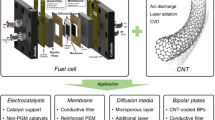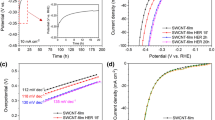Abstract
In this study, CsH5(PO4)2/quartz fiber thin membranes with thicknesses varying from 70 to 150 μm were prepared by a simple impregnation method and were tested as an electrolyte for fuel cell and electrolytic cell applications. The membranes consisted of a physical dispersion of CsH5(PO4)2 in the quartz fiber matrix. The crystalline structure and thermal behavior of CsH5(PO4)2 were not influenced by the quartz fiber. The membrane showed a high conductivity of 33 mS cm−1 at 180–250 °C under 30% H2O/Ar atmosphere. In addition, the membranes had area-specific resistances of 0.32 and 0.73 Ω cm2, for corresponding thicknesses of 70 and 150 μm, which are sufficiently low values compared with those of pellet-type electrolytes. The membrane showed stable conductivity at 220 °C under 30% H2O/Ar atmosphere for 20 h. A fuel cell assembled with the membrane exhibited an open-circuit voltage of 0.93 V and peak power densities of 105 and 72 mW cm−2, for corresponding thicknesses of 70 and 150 μm. In addition, ammonia was successfully synthesized from humidified hydrogen and nitrogen under atmospheric pressure in an electrolytic cell assembled with the membrane. An ammonia formation rate of 2.8 × 10−10 mol cm−2 s−1 and a Faradaic efficiency of 0.09% were obtained at 220 °C when the applied voltage was 0.05 V. With the increase of the applied voltage, both ammonia formation rate and Faradaic efficiency decreased rapidly.
Graphical abstract









Similar content being viewed by others
References
Toyota MC (2017) The 2017 Toyota Mirai fuel cell vehicle. https://ssl.toyota.com/mirai/fcv.html. Accessed 5 February 2017
JLPGA (2017) Home-use fuel cell (ENE-FARM). http://www.j-lpgas.gr.jp/en/appliances/index.html#ENE-FARM. Accessed 5 February 2017
Panagos E, Voudouris I, Stoukides M (1996) Modelling of equilibrium limited hydrogenation reactions carried out in H+ conducting solid oxide membrane reactors. Chem Eng Sci 51(11):3175–3180. doi:10.1016/0009-2509(96)00216-3
Marnellos G, Stoukides M (1998) Ammonia synthesis at atmospheric pressure. Science 282(5386):98–100. doi:10.1126/science.282.5386.98
Amar IA, Lan R, Petit CTG, Tao SW (2011) Solid-state electrochemical synthesis of ammonia: a review. J Solid State Electrochem 15(9):1845–1860. doi:10.1007/s10008-011-1376-x
Licht S, Cui BC, Wang BH, Li FF, Lau J, Liu SZ (2014) Ammonia synthesis by N2 and steam electrolysis in molten hydroxide suspensions of nanoscale Fe2O3. Science 345(6197):637–640. doi:10.1126/science.1254234
Lan R, Irvine JT, Tao S (2013) Synthesis of ammonia directly from air and water at ambient temperature and pressure. Sci Rep 3:1145. doi:10.1038/srep01145
Kim K, Lee N, Yoo CY, Kim JN, Yoon HC, Han JI (2016) Communication-electrochemical reduction of nitrogen to ammonia in 2-propanol under ambient temperature and pressure. J Electrochem Soc 163(7):F610–F612. doi:10.1149/2.0231607jes
Detz RJ, Sakai K, Spiccia L, Brudvig GW, Sun LC, Reek JNH (2016) Towards a bioinspired-systems approach for solar fuel devices. ChemPlusChem 81(10):1024–1027. doi:10.1002/cplu.201600446
Little DJ, Smith MR, Hamann TW (2015) Electrolysis of liquid ammonia for hydrogen generation. Energy Environ Sci 8(9):2775–2781. doi:10.1039/c5ee01840d
Lan R, Irvine JTS, Tao SW (2012) Ammonia and related chemicals as potential indirect hydrogen storage materials. Int J Hydrogen Energy 37(2):1482–1494. doi:10.1016/j.ijhydene.2011.10.004
Paschos O, Kunze J, Stimming U, Maglia F (2011) A review on phosphate based, solid state, protonic conductors for intermediate temperature fuel cells. J Phys-Condes Matter 23(23):234110. doi:10.1088/0953-8984/23/23/234110
Thoi VS, Usiskin RE, Haile SM (2015) Platinum-decorated carbon nanotubes for hydrogen oxidation and proton reduction in solid acid electrochemical cells. Chem Sci 6(2):1570–1577. doi:10.1039/c4sc03003f
Varga A, Pfohl M, Brunelli NA, Schreier M, Giapis KP, Haile SM (2013) Carbon nanotubes as electronic interconnects in solid acid fuel cell electrodes. Phys Chem Chem Phys 15(37):15470–15476. doi:10.1039/c3cp52586d
Xiao J, Zhang HM, Yang ZJ, Wang HT, Ma GL, Zhou ZF (2012) Proton and oxide-ion conduction in ZnO doped SnP2O7 ceramics. J Alloy Compd 521:106–111. doi:10.1016/j.jallcom.2012.01.058
Norby T (2001) The promise of protonics. Nature 410(6831):877–878. doi:10.1038/35073718
Jin YC, Lee B, Hibino T (2010) Development and application of SnP2O7-based proton conductors to intermediate-temperature fuel cells. J Jpn Pet Inst 53(1):12–23. doi:10.1627/jpi.53.12
Hibino T (2011) Intermediate-temperature proton conductors and their applications to energy and environmental devices. J Ceram Soc Jpn 119(1393):677–686. doi:10.2109/jcersj2.119.677
Muroyama H, Matsui T, Kikuchi R, Eguchi K (2008) Influence of the supporting matrix on the electrochemical properties of CsH5(PO4)2 composites at intermediate temperatures. J Phys Chem C 112(39):15532–15536. doi:10.1021/jp8043362
Matsui T, Kukino T, Kikuchi R, Eguchi K (2006) Composite effects of silicon pyrophosphate as a supporting matrix for CsH5(PO4)2 electrolytes at intermediate temperatures. Electrochim Acta 51(18):3719–3723. doi:10.1016/j.electacta.2005.10.026
Matsui T, Muroyama H, Kikuchi R, Eguchi K (2010) Development of novel proton conductors consisting of solid acid/pyrophosphate composite for intermediate-temperature fuel cells. J Jpn Pet Inst 53(1):1–11. doi:10.1627/jpi.53.1
Lavrova GV, Ponomareva VG (2008) Intermediate-temperature composite proton electrolyte CsH5(PO4)2/SiO2: transport properties versus oxide characteristic. Solid State Ionics 179(21–26):1170–1173. doi:10.1016/j.ssi.2008.01.003
Muroyama H, Akagi T, Matsui T, Eguchi K (2012) Mixed alkali effect on thermal and electrochemical properties of MH5(PO4)2/SiP2O7 composite electrolytes at intermediate temperatures. Solid State Ionics 225:663–666. doi:10.1016/j.ssi.2012.03.037
Goni-Urtiaga A, Presvytes D, Scott K (2012) Solid acids as electrolyte materials for proton exchange membrane (PEM) electrolysis: review. Int J Hydrogen Energy 37(4):3358–3372. doi:10.1016/j.ijhydene.2011.09.152
Muroyama H, Kudo K, Matsui T, Kikuchi R, Eguchi K (2007) Electrochemical properties of MH2PO4/SiP2O7-based electrolytes (M = alkaline metal) for use in intermediate-temperature fuel cells. Solid State Ionics 178(27–28):1512–1516. doi:10.1016/j.ssi.2007.09.005
Matsui T, Noto T, Muroyama H, Iijima M, Eguchi K (2011) Intermediate-temperature fuel cell employing thin-film solid acid/phosphate composite electrolyte fabricated by electrostatic spray deposition. J Power Sources 196(22):9445–9450. doi:10.1016/j.jpowsour.2011.07.004
Gradisek A, Dimnik B, Vrtnik S, Wencka M, Fraczek MZ, Lavrova GV, Dolinsek J (2011) The hydrogen dynamics of CsH5(PO4)2 studied by means of nuclear magnetic resonance. J Phys-Condes Matter 23(8):085901. doi:10.1088/0953-8984/23/8/085901
Qing GLT, Kikuchi R, Takagaki A, Sugawara T, Oyama ST (2014) CsH5(PO4)2 doped glass membranes for intermediate temperature fuel cells. J Power Sources 272:1018–1029. doi:10.1016/j.jpowsour.2014.09.025
Qing G, Kikuchi R (2016) Interfacial interaction and melting point depression of CsH5(PO4)2 in CsH5(PO4)2/SiO2 composites. Solid State Ionics 289:133–142. doi:10.1016/j.ssi.2016.03.013
Andriyevsky B, Zdanowska-Fraczek M (2012) DFT-based ab initio study of band structure of CsH5(PO4)2 crystals. Solid State Ionics 207:14–20. doi:10.1016/j.ssi.2011.11.027
Croce F, Cigna G (1982) Determination of the protonic transference number for KH2PO4 by electromotive force measurements. Solid State Ionics 6(3):201–202. doi:10.1016/0167-2738(82)90039-X
Kikuchi R, Ogawa A, Matsuoka T, Takagaki A, Sugawara T, Oyama ST (2016) Interfacial conduction mechanism of cesium hydrogen phosphate and silicon pyrophosphate composite electrolytes for intermediate-temperature fuel cells. Solid State Ionics 285:160–164. doi:10.1016/j.ssi.2015.10.008
Qing G, Kikuchi R, Takagaki A, Sugawara T, Oyama ST (2016) Stability of CsH5(PO4)2-based composites at fixed temperatures and during heating-cooling cycles for solid-state intermediate temperature fuel cells. J Power Sources 306:578–586. doi:10.1016/j.jpowsour.2015.12.101
Yoshimi S, Matsui T, Kikuchi R, Eguchi K (2008) Temperature and humidity dependence of the electrode polarization in intermediate-temperature fuel cells employing CsH2PO4/SiP2O7-based composite electrolytes. J Power Sources 179(2):497–503. doi:10.1016/j.jpowsour.2008.01.003
Matsui T, Kukino T, Kikuchi R, Eguchi K (2006) Intermediate-temperature fuel cell employing CsH2PO4/SiP2O7-based composite electrolytes. J Electrochem Soc 153(2):A339–A342. doi:10.1149/1.2142211
Ryu YG, Pyun SI, Kim CS, Shin DR (1998) A study on the formation of surface functional groups during oxygen reduction on a platinum-dispersed carbon electrode in an 85% H3PO4 solution at elevated temperature. Carbon 36(3):293–298. doi:10.1016/S0008-6223(97)00188-7
Matsui T, Kukino T, Kikuchi R, Eguchi K (2005) An intermediate temperature proton-conducting electrolyte based on a CsH2PO4/SiP2O7 composite. Electrochem Solid State Lett 8(5):A256–A258. doi:10.1149/1.1883906
Lan R, Tao SW (2013) Electrochemical synthesis of ammonia directly from air and water using a Li+/H+/NH4 + mixed conducting electrolyte. RSC Adv 3(39):18016–18021. doi:10.1039/c3ra43432j
Amar IA, Petit CTG, Lan R, Mann G, Tao SW (2014) Electrochemical synthesis of ammonia from wet nitrogen using La0.6Sr0.4FeO3−δ -Ce0.8Gd0.18Ca0.02O2−δ composite cathode. RSC Adv 4(36):18749-18754. doi:10.1039/c4ra02090a
Lan R, Alkhazmi KA, Amar IA, Tao SW (2014) Synthesis of ammonia directly from wet air at intermediate temperature. Appl Catal B: Environ 152:212–217. doi:10.1016/j.apcatb.2014.01.037
Fan LD, Zhang GQ, Chen MM, Wang CY, Di J, Zhu B (2012) Proton and oxygen ionic conductivity of doped ceria-carbonate composite by modified Wagner polarization. Int J Electrochem Sci 7(9):8420–8435
Shao YY, Yin GP, Wang ZB, Gao YZ (2007) Proton exchange membrane fuel cell from low temperature to high temperature: material challenges. J Power Sources 167(2):235–242. doi:10.1016/j.jpowsour.2007.02.065
Zhang JL, Xie Z, Zhang JJ, Tanga YH, Song CJ, Navessin T, Shi ZQ, Song DT, Wang HJ, Wilkinson DP, Liu ZS, Holdcroft S (2006) High temperature PEM fuel cells. J Power Sources 160(2):872–891. doi:10.1016/j.jpowsour.2006.05.034
Amar IA, Lan R, Petit CTG, Arrighi V, Tao SW (2011) Electrochemical synthesis of ammonia based on a carbonate-oxide composite electrolyte. Solid State Ionics 182(1):133–138. doi:10.1016/j.ssi.2010.11.009
Amar IA, Lan R, Petit CTG, Tao S (2015) Electrochemical synthesis of ammonia using Fe3Mo3N catalyst and carbonate-oxide composite electrolyte. Int J Electrochem Sci 10(5):3757–3766
Amar IA, Lan R, Petit CTG, Tao SW (2015) Electrochemical synthesis of ammonia based on Co3Mo3N catalyst and LiAlO2-(Li, Na, K)2CO3 composite electrolyte. Electrocatalysis 6(3):286–294. doi:10.1007/s12678-014-0242-x
Li YG, Wang HL, Xie LM, Liang YY, Hong GS, Dai HJ (2011) MoS2 nanoparticles grown on graphene: an advanced catalyst for the hydrogen evolution reaction. J Am Chem Soc 133(19):7296–7299. doi:10.1021/ja201269b
Abghoui Y, Garden AL, Hlynsson VF, Bjorgvinsdottir S, Olafsdottir H, Skulason E (2015) Enabling electrochemical reduction of nitrogen to ammonia at ambient conditions through rational catalyst design. Phys Chem Chem Phys 17(7):4909–4918. doi:10.1039/c4cp04838e
Abdelkader A, Ammar AA, Saleh SI (1991) Thermal behaviour of ammonium dihydrogen phosphate crystals in the temperature range 25–600 °C. Thermochim Acta 176:293–304. doi:10.1016/0040-6031(91)80285-Q
Patnaik P (2003) Handbook of inorganic chemicals. McGraw-Hill, New York
Acknowledegments
This work was supported by CREST, Japan Science and Technology Agency (JST).
Author information
Authors and Affiliations
Corresponding author
Electronic supplementary material
Below is the link to the electronic supplementary material.
Rights and permissions
About this article
Cite this article
Qing, G., Sukegawa, K., Kikuchi, R. et al. CsH5(PO4)2/quartz fiber thin membranes for intermediate temperature fuel cells and electrochemical synthesis of ammonia. J Appl Electrochem 47, 803–814 (2017). https://doi.org/10.1007/s10800-017-1082-1
Received:
Accepted:
Published:
Issue Date:
DOI: https://doi.org/10.1007/s10800-017-1082-1




